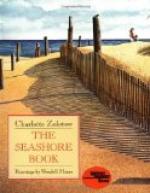Now if you look at the pebbles on the shore you see that many of them are smooth and round. Some are as round as the “marbles” you play with. No wonder, for the mighty sea has scoured them with sand and rolled them for miles.
As you know, the sea is not always at the same height. It falls and rises. Twice in every day it ebbs and flows; we call this movement of the sea the tides. At low tide we can explore the very bed of the ocean. We can visit the homes of the living, breathing animals, which, at high tide, are hidden far under water. Between the high-water mark and low-water mark is our hunting-place. There we shall find the play-ground and feeding-ground of many a strange creature.
Here is a stretch of sand, with little channels of water; there is a patch of shingle mixed with numbers of tiny shells. The ebbing tide leaves shallow pools in every hollow of the beach, and these pools are often full of life.
Shrimps dart away and disappear in the sand as if by magic. Small fish and crabs hide from you as best they can. Helpless jelly-fish and starfish sprawl on the wet sand. What are those thin ropes of sand coiled up into little mounds? They remind us of “worm-casts.” They are thrown up by a sand-worm, called “lug-worm” by the fisherman. He brings a spade and digs wherever he sees the sandy ropes of the “lug,” for this worm makes good fishing bait.
Seagulls love to explore the shallow pools. You may see them walking solemnly about, picking up stray morsels. If you see a screaming group of them you can be sure that one has found an extra large prize, and the others mean to share the feast.
Let us walk down the beach towards the sea. Soon we find ourselves among rocks. Now these rocks are the bare bed of the shore, stripped of all covering. There is no mud, sand, or shingle, so here you see plainly the work done by the restless water. On every side you notice rocks worn to all shapes and sizes. Some jut out as sharp ledges. Others are flat tables, covered with a table-cloth of sea-plants. These clothe the rocks, or hang over the ledges like wet, shining green curtains. Nearly every rock has its crust of barnacles and clumps of mussels. If we are not careful we slip on the wet weeds, and get a ducking in the pools which lie everywhere among the rocks.
Here is the best place of all for sharp eyes to find the animals and plants we seek. Where the hard rock has been worn down into hollows, the falling tide leaves a pool of still, clear water. These rock-pools are the home of many a creature. So let us look for them, until the rising tide sweeps over the rocks once more, and drives us away.
Sea-anemones and seaweeds brighten the pool with their various colours. Pretty shells gleam here and there; and on the face of the rock there are more limpets, barnacles and mussels than we can count.
Where are the other living animals which we came to find? You will not see them unless you hunt for them in the right way. It is a game of “hide-and-seek.” They are the “hiders”; and, as their lives often depend on their skill in hiding, you cannot wonder that they know every trick in the game.




